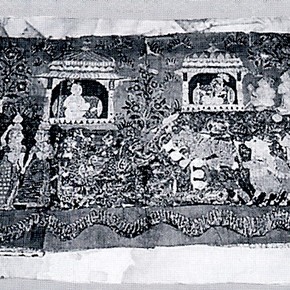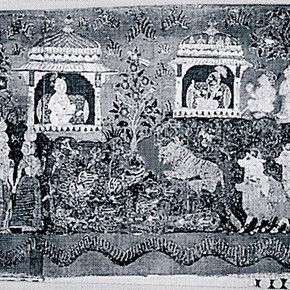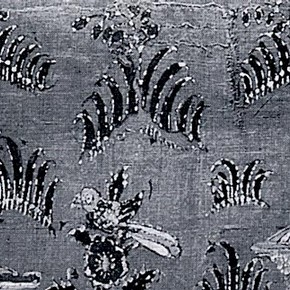Conservation Journal
January 1995 Issue 14
The tail of the tiger: conservation of a pichhwai fragment
The textile fragment with which this article is concerned (Museum no. IS 27 -1983) was once part of a larger hanging used to decorate the rear wall of a temple shrine dedicated to Krishna. This type of decoration is characteristic of the Vallabhacharya sect and this particular fragment is both early and rare, dating to the late eighteenth or early nineteenth century. Many textiles were used to decorate the shrines, the most important of which was the pichhwai. The word means `the thing behind' and simply describes the position of the hanging in relation to the image of the god. They were varied according to the season or festival and also depended on the wealth of the temple. They could be made of cotton or silk and were embroidered, brocaded, dyed or painted. Many of them, like the fragment described here, are figurative, and depict scenes in the life of Krishna. The great freedom of expression found in these textiles is very appealing and as a result they are very collectable.
The fragment is quite small, only 38 x 55 cm, and arrived at the Museum mounted on an irregularly shaped piece of stencilled cotton. (Fig. 1) Near the left hand edge there is a vertical seam which has been crudely oversewn along the selvedges of two partial loom widths of plain weave cotton. The images have been painted and mordant dyed in the kalamkari technique, then gilded using gold leaf applied to a gum. The ground is green and brown with blue, red and tan decoration of various shades. The natural colour of the cotton is used for flesh tones.
Condition
The fragment was substantially complete except in the centre where many small patches had been used to cover areas of loss. The patches, together with distortions, served to obscure the iconography in this area. The fragment had been adhered with starch paste to an irregularly shaped backing cloth which was both dirty and stained. This cloth was stencilled in a pattern of red, black and yellow and had obviously been reused. The main areas of damage were in the brown dyed part of the fragment, a natural consequence of the use of iron mordants in the original dyeing, as iron degrades cellulose fibres. There were numerous holes and areas of abrasion. Water damage had caused staining which was particularly noticeable in the top green area. The fragment appears to have been torn down the left hand edge while the other edges show a mixture of tear and cut. The gold on red patches were cut from the bottom border; others appeared to have been torn or cut from the edges. It was not possible to tell if all the patches belonged to the main fragment before they were removed and separated. Slits and tears were also present. There was a patch of coarse brown cloth attached by red thread at the bottom centre of the fragment.
Treatment
In treatment of the fragment, the first priority was to remove all the patches and the backing fabric so that the extent of the damage could be assessed. The patches were removed first as they overlapped the large fragment and each other. They were eased off carefully with the aid of a spatula. Often several patches were removed together and separated from each other later. The old backing was also removed this way. This backing was of curatorial interest so it was tidied up by removing the large lumps of starch which remained on the surface, then rolled for storage and sent back to the section.
The fragment was very fragile, especially in the areas dyed brown. This was due largely to the use of iron mordant to produce the brown which over the years has caused embrittlement of the fibres. The embrittlement, together with the painted and gilded surface, led to the use of a thermoplastic adhesive support. This type of support, together with some supplementary stitching, has been found to give very satisfactory results for objects which show this type of deterioration 1 . Vinamul 3252, a vinyl acetate and ethylene copolymer, was chosen as the adhesive as it gives a flexible and conformable film. This adhesive is unsuitable for objects on open display as its low glass transition temperature (Tg = 3°C) means it remains slightly tacky at room temperature. For small objects such as this one, which are to be displayed in a case, this disadvantage is outweighed by its ability to conform readily to an uneven surface.
The fragment was surface - cleaned using the vacuum tweezer unit to remove loose starch fragments after any large starch lumps had been removed from the back using forceps. It was relaxed by using a cold poultice method and pinned out to remove creases and distortions in the weave. The small patches were treated similarly, though they were so distorted and heavily impregnated with starch that the treatment had to be repeated several times. Each time, excess starch was picked off using fine forceps and the weave straightened as far as possible with the patch under magnification. The patches were dried under glass weights as otherwise the starch caused them to curl.
When all the patches had been separated it was found that all but three of the fourteen belonged to the main fragment. This was quite surprising as many Indian textiles were patched with any fabric that came to hand, whether it matched or not 2 . The three patches which could not be placed almost certainly came from another section of the original textile. The green is identical to that of the top of the fragment, while the blue matches that of three threads which are all that is left of the background to the section above.
The support fabric chosen was a dark brown Stabiltex. This sheer polyester fabric was chosen for its strength and the colour because most of the damage was in the brown dyed areas of the fragment. As the fabric is sheer, a very subtle effect was achieved by the use of specially dyed patches behind the areas of loss. A 20% solution of Vinamul 3252 in deionised water was brushed onto the Stabiltex using polythene as the release surface. Approximately 100 ml of solution per m2 was required.
The adhesion of the support was made by hand using a domestic iron and spatula iron set at 80°C. The fragment was laid face down on Melinex and cushioned with four layers of flannelette sheeting. Two pieces of Stabiltex were used to mimic the original construction of the fragment. The support could then be aligned to each cotton width and taken into the seam, supporting the seam allowance. Only the sound areas of the fragment were treated from the back. In order to align the patches correctly, the fragment was put face up and the patches were placed using finger pressure. Similarly, the alignment of the damaged areas was checked with the fragment face up and adhered lightly from the front using a spatula iron. Silicon release paper was used between the textile and the iron at all times. Once the pieces had been correctly placed, full adhesion was achieved from the back of the object. IMS (industrial methylated spirit) was used on a cotton swab to reduce the shine of the adhesive on the Stabiltex where large areas of the textile were missing.
The consolidated textile was then lined with cotton lawn. An overall support of cream, matching the ground colour, was chosen, as it would show at the bottom of the piece where fragile small fragments needed support. This colour was obviously not acceptable for holes in the brown and green areas of the textile, so patches dyed to match were used in these areas. These patches were attached to the lining of the fragment, not the fragment itself. Laid threads in pulled Stabiltex were used to secure the small fragments and vulnerable areas. The main fragment was attached to the lining using long and short stitch in pulled Stabiltex.
The three small fragments which did not belong to the main piece were attached to the lining so that, while they were physically associated with the fragment, they would not be visible on display. The fragment was then sewn to a lightly padded board, using slip stitch which only pierced the lining. (Fig. 2) It went on display in the Nehru gallery in November 1994.
Background information
While the conservation was going on, some research into the history of pichhwais was carried out to try to ascertain the type of hanging to which the V&A fragment may have belonged and its position in that hanging. This could have important implications in the mounting of the fragment. Two hangings were found which had very similar styles. They were both very large, more than two metres in each direction, with a large (approximately life size) central picture of Krishna playing the flute surrounded by the gopis. They have pictorial borders showing scenes in the life of Krishna surrounded by floral borders. The feet of the large figures encroach slightly on these pictorial borders. The pictorial borders both showed scenes which were strikingly similar in style and iconography to the V&A fragment. One of these pichhwais, from the Calico Museum in Ahmedabad, even has tigers showing the long tail which is such a feature of the one at the centre of the fragment. There are two other pieces of evidence which point to the V&A fragment originally belonging to a hanging similar to the one in Ahmedabad as part of the border of a huge pichhwai. The first is the three threads tipped in blue which were found along the top edge of the fragment, which could correspond to the background of the major motif. The second is the appearance of what seem to be toe tips, again along the top edge of the fragment. (Fig. 3)
Conclusion
In conclusion, thermoplastic adhesives have become an established treatment in the support of fragile textiles where stitching alone is inappropriate and this method, together with stitches laid over small fragments, was felt to be the most appropriate to support this fragment. The use of dark brown Stabiltex together with custom dyed cotton lawn linings minimised the visual impact of the areas of loss. This was particularly important along the bottom of the fragment, where a neutral shade was used to avoid making a statement concerning the original composition of that area. Further support was provided by a padded board. The attachment of the related fragments to the lining means that they will remain with the object, though not visible.
Materials
Cotton lawn.
IMS (industrial methylated spirit).
Melinex.
Silicon release paper.
Stabiltex. Vinamul 3252.
In the conservation of this fragment historical research was very important to avoid giving a misleading impression by inappropriate display techniques. Conservation has revealed the original pictorial design as well as making the fragment safe for display.
References
1. Gentle, N. The Examination and Conservation of Two Indian Textiles. The Conservator, No.17,1993, p20.
2. Ibid., p 21.
January 1995 Issue 14
- Editorial
- Ceremonial hat for eating Bouillabaisse: Eileen Agar 1936
- Measuring pollution in the museum environment
- The tail of the tiger: conservation of a pichhwai fragment
- The role of the 'barefoot' conservator
- Review: polymers in museums
- Review: 'New Horizons': the designer bookbinders' conference
- Review: the annual conference of the association for historical and fine art photographers
- RCA/ V&A new students for the academic year 1994/95


